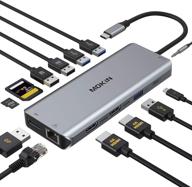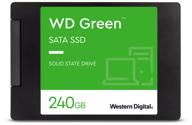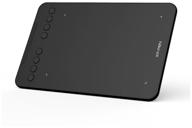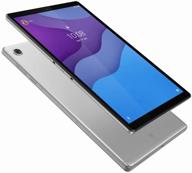
Review on Cable Matters USB C Dock for Windows - Dual 4K DisplayPort, 80W Charging, SD Card Slot, 10Gbps USB-A/USB-C Gigabit Ethernet - Thunderbolt 4 / USB4 / Thunderbolt 3 Port Compatible USB C Docking Station for Enhanced Performance by Daniel Casper

TL; DR USB-C is confusing. This document is the best way to find out what you're getting.
This dock is the only one I've been sure of what I'm getting and can choose between different configurations with the mode switch. The USB-C/Thunderbolt world is opaque today, and the only way to know what you're getting is with lots of reading and guessing. I'll share what I've learned about USB-C here to explain why I chose this docking station. Your USB-C cable contains 4 configurable pairs of wires. When the cable is connected, both parties agree on how to set up these pairs. Any of these can become: - a USB 3* strip - a DisplayPort strip - a Thunderbolt strip - some other configurations that include MHL or HDMI (I couldn't find that much information about them). Different "alternate modes" define different possible band configurations. - Standard: 2 or 4 channels USB 3* - Alternative DisplayPort mode: 2 channels USB 3* + 2 channels DisplayPort or 4 channels DisplayPort - Thunderbolt 3 mode: 4 channels Thunderbolt - Alternative HDMI mode: 4 channels HDMI*USB3 can 5 Gb/s or 10 Gb/s. There should always be a pair of lanes: one 5Gbps lane = one 5Gbps TX lane + one 5Gbps RX lane. The proprietary terminology is confusing, but it's important to note that USB 3.1 introduced 10Gbps lanes (referred to as "Generation 2") and USB 3.2 introduced two channels instead of one (four channels instead of two). The USB-C cable also includes two USB 2.0 pairs (one RX, one TX) that never change configuration. It is therefore always available with speed 2.0 (480 Mbps) in HDMI Alt Mode or 4x DisplayPort USB Alt Mode. In DisplayPort Alternate Mode, the USB lines become DisplayPort lines. Most (all?) USB-C chips today use DisplayPort 1.2a, which can deliver 4K at 30Hz with 2 lanes and 4K at 75Hz with 4 lanes. So the 4K/HD switch on the Cable Matters docking station explains it all. It only switches between alternate mode configurations. : DisplayPort 1.2a Lane 1 - Lane 2: DisplayPort 1.2a Lane 2 - Lane 3: USB3 TX - Lane 4: USB3 RX. What about other docking stations? I'm suspicious of any USB-C docking station with HDMI instead of DisplayPort. True HDMI Alternate Mode is less commonly used than DisplayPort Alternate Mode, so I suspect that unless your USB-C dock specifically says "HDMI Alternate Mode," it's most likely using DisplayPort Alternate Mode with an active HDMI converter**. My experiences with such active converters are mixed: last time I had to turn on the display exactly 1.5 seconds after waking up my laptop, otherwise it wouldn't work. (**Typically DP++/Dual Mode can pass HDMI signals over DisplayPort with a passive adapter, but this is not supported on USB-C) Thunderbolt 3 is the "extra set" of USB-C. It can use dedicated cables with 20 Gbps lanes (40 Gbps total in each direction) and offers USB, DisplayPort 1.2a and PCIe 3.0 on the link. When connected to a basic USB-C host, the Thunderbolt 3 Dock may revert to a different alternate mode for USB and DisplayPort functionality, but anything that relies on PCIe has no fallback path and will not work. Some Thunderbolt 3 docking stations are really just external PCIe graphics cards that won't work on plain USB-C hosts. Worse, any USB-C docking station could actually be a USB graphics card instead of using DisplayPort Alternate Mode. Although they are "universal", they may require specific drivers that are not available on all platforms (Chromebooks in particular). Why is this so confusing? The heart of the problem lies in the fact that the software support is not where it should be. To my knowledge, there is no option in any operating system to display the current USB-C port mode or to choose between supported modes (e.g. 2x or 4x DisplayPort alternate mode). I believe every operating system will have tools like this in the future, but as long as we have them, the only way consumers can know what they're getting is by reading white papers, forum posts, and relying on guesswork. So why this docking station? As far as I know, the mode switch on the Cable Matters Dock is currently the only hardware or software way to choose between supported modes. Additionally, the presence of the switch shows that this docking station simply uses DisplayPort Alternate Mode with no other dedicated active components. A switch would not make sense in any other architecture. I want to know what I'm getting, that's why I chose this dock.
- Great price
- Annoyed
New products
Comments (0)
Top products in 🔌 Docking Stations

Experience Seamlessly Connected Productivity: USB C Hub Docking Station with Triple Display, Dual HDMI 4K, DP, PD Charger, Gigabit Ethernet, USB Ports, SD/TF Card Reader - Ideal for MacBook Pro and Windows

11 Review

Dell 452-BCYT D6000 Universal Dock in Black: A Hassle-free Single Solution

17 Review

12-in-1 USB C Docking Station: Dual Monitor, Triple Display, 4K HDMI, VGA, Gigabit Ethernet, SD/TF Card Reader - Compatible with MacBook/Surface/HP/Dell

11 Review

Enhanced HP USB-C/A Universal Dock G2 - Optimal for Seamless Connectivity (Part#: 5TW13AA#ABA)

11 Review






